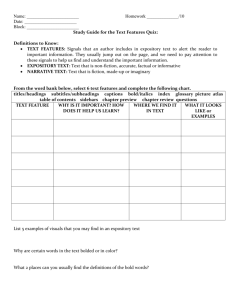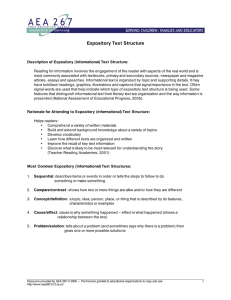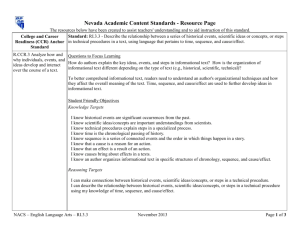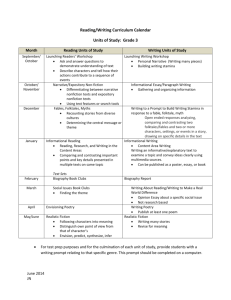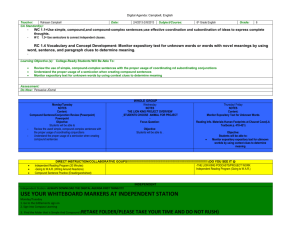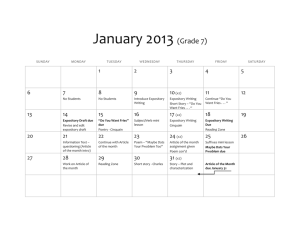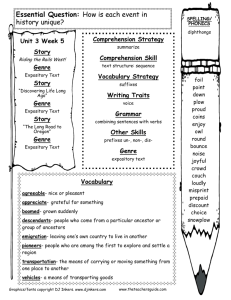Class 10-F15
advertisement
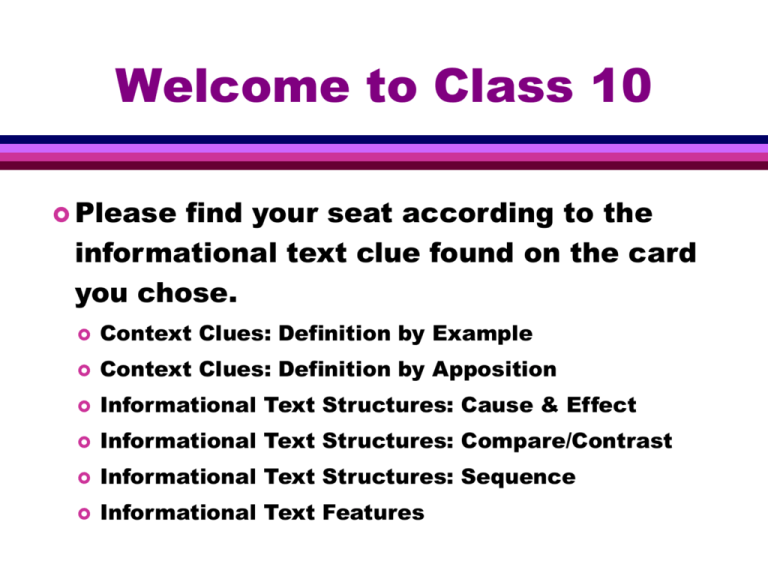
Welcome to Class 10 Please find your seat according to the informational text clue found on the card you chose. Context Clues: Definition by Example Context Clues: Definition by Apposition Informational Text Structures: Cause & Effect Informational Text Structures: Compare/Contrast Informational Text Structures: Sequence Informational Text Features Welcome to Class 10 Last Class for this quarter Instructional focus: • Teaching Students to Read Expository Texts CLS Submission Guidelines Course Evaluations Expository/Informational Texts In your table groups... Share your Chapter 9 Reading Guide Story and Learning Activity The story for this class is The Lotus Seed by Sherry Garland. The strategy is Anticipation Guides. Anticipation Guides Before you read, mark the statements that you think are likely to be true with (T). The Lotus Seed Vietnam was once a kingdom. Vietnam was once a Spanish colony. The áo dài is a special kind of dress. The Bao Dai is a special costume for Vietnamese men. Lotus blossoms grow on a tree, much like magnolias. Vietnam gained independence in 1954. The USA left Vietnam in ____. Anticipation Guides After having heard the story, read the text selection and mark the statements again, using information you learned from the text. The Lotus Seed Vietnam was once a kingdom. Vietnam was once a Spanish colony. The áo dài is a special kind of dress. The Bao Dai is a special costume for Vietnamese men. Lotus blossoms grow on a tree, much like magnolias. Vietnam gained independence in 1954. The USA left Vietnam in 1975 Classroom Application How might you use Anticipation Guides in a classroom? • For what instructional purpose/s would it be appropriate? • For whom would it be appropriate? What adaptations might you make? Why? How might you use this story? What considerations would you make? Why? Classroom Application To activate background knowledge before reading content area textbooks and informational books • Can also be done with narrative text Sts change some of their opinions, realizing they have refined their understanding of the subject through the activity Having questions in mind when you read gives you a purpose for reading and directs attention to big ideas Agenda for Class 10: Expository/Informational Text Narrative and Expository Text Features Expository Text Structures Signal Words Graphic Organizers Context Clues Narrative Text Writing that tells a story: • • • • • • Picture books Fairy Tales Short stories Novels Fables Myths and legends Narrative Text Elements (Structure) Setting Characters • Dialogue Plot • Problem(s) • Attempts to resolve problem(s) • Resolution Theme or Moral Expository Text Writing that provides information Written in paragraphs: • • • • • • Essays Textbook chapters Editorials Articles Reports Manuals Reading Expository Texts Requires Comprehension Strategies Such As… Asking/Answering Questions Drawing inferences Determining important ideas Summarizing and Synthesizing information Creating visual images (graphic organizers) Expository, Non-Fiction, Informational??? Often the terms “informational text” and “nonfiction” are used interchangeably. Nonfiction includes any text that is factual. Informational text is a type of nonfiction. The primary purpose of informational text is to convey information about the natural or social world. We use expository and informational interchangeably. Common Core State Standards RI.2.5: • Know and use various text features (e.g., captions, bold print, subheadings, glossaries, indexes, electronic menus, icons) to locate key facts or information in a text efficiently Comparison Expository Text Features I Have...Who Has? Text Features Expository/Informational Text External Organization (Text Features) • Format features (introduction, summary, headings, graphs, charts, illustrations, etc.) Internal Organization (Text Structures) • Characterized by interrelationships among ideas • Represent different types of logical connections among ideas • Good readers know how to look for these relationships (structures) to help them further understand what they are reading. Expository/Informational Text Class 10 resources folder Common Core State Standards RI.4.5: • Describe the overall structure (e.g., chronology, comparison, cause/effect, problem/solution) of events, ideas, concepts, or information in a text or part of a text. Expository Text Structures Enumeration (Description) • A topic, event, object or person is described by listing characteristics, features, traits, and examples Time Order (Sequence) • Putting facts, events, or concepts into a sequence, using references to time (such as dates) to order them Expository Text Structures Comparison-Contrast • Pointing out similarities and/or differences among facts, people, events, concepts, etc Cause-Effect • Showing how facts, events or concepts (effects) happen because of other facts, events or concepts (causes) Problem-Solution • The writer states a problem and offers one or more solutions Text Structure Sorting Activity You have a collection of text passages in your envelope. Determine which text structure is dominant in each of the passages. Sort the passages under the appropriate heading. Be ready to articulate the rationale for your decisions. Why is this important? Why do Teachers Need to Know This? When students use the five expository text structures to organize their reading and writing, they are more effective readers and writers. Meaning making is enhanced when readers recognize the structure of ideas and relationships in a text. Good readers know how to look for these relationships. Signal Words Often, the text pattern is signaled clearly by means of titles, topic sentences, and cue words. It therefore can be important to teach students to look for these cue words. Signal Words If readers are looking for the signals, they are better able to access the text pattern. This can facilitate comprehension. Note: Linguists call these words connectives because they connect one idea to another (Halliday & Hasan, 1976). Signal Word Sort You have received a card containing either a signal word or a text structure. In a moment, you will stand up, find a partner, and read the word or phrase on your card. If your cards seem to belong to the same text structure, stick together. Your objective: sort yourselves into groups containing 1 text structure and related signal words. Text Organization Application Activity In your groups, read the paragraph that you have been assigned. Decide how the paragraph is organized: • Sequence, description, compare/contrast, cause/effect, or problem/solution Draw (choose) a graphic organizer that would be appropriate for this paragraph. Fill out the graphic organizer with the information from the paragraph Record your work on the paper provided. Be prepared to share If you finish early, you may either choose another paragraph or a passage from the text you brought. Graphic Organizers Each text structure can be represented by graphic organizers. Teaching students how to use and create graphic organizers can help them be better readers of expository texts. CONTEXT DETECTIVE CONTEXT CLUES WITH THE CONTEXT DETECTIVE Context Clues Formal Definition • The meaning of the word is expressed in a direct statement. • Example: Mitosis is the process of cell division consisting of prophase, metaphase, anaphase, and telophase. Context Clues Definition by Example • Can further clarify the formal definition • Example: The following are examples of the commutative property: a+b = b+a ab = ba Context Clues Definition by Description • Provides description of the physical qualities or characteristics of the object which the word represents • Example: The capybara looks like a giant guinea pig with webbed feet. Context Clues Definition by Comparison/Contrast • This method gives the author the opportunity to stretch the meanings of words and to be creative in her/his descriptions. • Example: While both metaphors and similes compare something to something else, similes are signaled by the use of like or as. Context Clues Definition by Synonym • Probably the shortest defining device • Example: Peanuts are also known as goobers, groundnuts, and groundpeas. Context Clues Definition by Apposition • The appositive clue is a parenthetical word or phrased used to clarify or define. • Example: Cubism, an abstract art form that incorporates intersecting and often transparent cubes and cones, is usually attributed to Picasso. Context Clues Definition by Origin • An explanation of the history of a word can fix its meaning by providing a setting in which the word can be placed and remembered. • Example: Morphology is the study of word formation, including the origin and function of inflections and derivations (morph=shape, form or structure; ology=indicates the study of). Context Clues Find examples of at least one of the contextual clues in an informational text. Share with your table mates. Be prepared to share with the class. Context Clues Formal definition Definition by example Definition by description Definition by compare/contrast Definition by synonym Definition by apposition Definition by origin CLS/edTPA Submission Guidelines Homework Read: Tompkins Chapter 11 – Differentiating For Success pp. 360 – 390 Comprehension Learning Segment • Due by Wednesday, December 16 @ 5:00 on GauchoSpace Completed Literacy Assessment (including Language Arts Program and Reflection sections) • Due on or before January 11, 2016 • Due date for ITCs is December 18, 2015 RICA Review Optional December 4th 8:30-11:30 Room 1217 Sign up by midnight tonight RICA Review FYI This course is 2 units in the fall and 3 units in the winter This quarter you will receive a S/U as a placeholder grade Your final grade including all assignments will be reflected in your winter quarter grade when the class is weighted with more units and scored with a letter grade Ta Da! There are two course evaluations • ESCIs (1 for each instructor) • Zoomerang There is a F15 course summary to help. Thank you! …for a great quarter full of excellent questions, insights, and growth! Cheers to all of your hard work and to all of your future students who will benefit from having YOU as their teacher! Sincerely, Ann and Danielle
